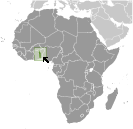World Atlas: Togo. On this page you can see the map, country flag and many detailed information about the people, history and economy of Togo.

Here you can find online selected information about the geography, inhabitants, government, economy and history of Togo. Included are selected statistics, an overview map and the detailed map of Togo. But let's start with the flag of Togo here:
Togo - Overview:
What you should know about Togo? Let's start with this: French Togoland became Togo in 1960. Gen. Gnassingbe Eyadema, installed as military ruler in 1967, ruled Togo with a heavy hand for almost four decades. Despite the facade of multi-party elections instituted in the early 1990s, the government was largely dominated by President Eyadema, whose Rally of the Togolese People (RPT) party has been in power almost continually since 1967 and its successor, the Union for the Republic, maintains a majority of seats in today's legislature. Upon Eyadema's death in February 2005, the military installed the president's son, Faure Gnassingbe, and then engineered his formal election two months later. Democratic gains since then allowed Togo to hold its first relatively free and fair legislative elections in October 2007. Since 2007, President Gnassingbe has started the country along a gradual path to political reconciliation and democratic reform, and Togo has held multiple presidential and legislative elections that were deemed generally free and fair by international observers. Despite those positive moves, political reconciliation has moved slowly and many Togolese complain that important political measures such as presidential term limits and electoral reforms remain undone, leaving the country’s politics in a lethargic state. Internationally, Togo is still known as a country where the same family has been in power for five decades.
Geography of Togo
 Where on the globe is Togo? The location of this country is Western Africa, bordering the Bight of Benin, between Benin and Ghana. Total area of Togo is 56,785 sq km, of which 54,385 sq km is land. So this is not a large country. How could we describe the terrain of the country? This way: gently rolling savanna in north; central hills; southern plateau; low coastal plain with extensive lagoons and marshes. The lowest point of Togo is Atlantic Ocean 0 m, the highest point Mont Agou 986 m. And the climate is tropical; hot, humid in south; semiarid in north.
Where on the globe is Togo? The location of this country is Western Africa, bordering the Bight of Benin, between Benin and Ghana. Total area of Togo is 56,785 sq km, of which 54,385 sq km is land. So this is not a large country. How could we describe the terrain of the country? This way: gently rolling savanna in north; central hills; southern plateau; low coastal plain with extensive lagoons and marshes. The lowest point of Togo is Atlantic Ocean 0 m, the highest point Mont Agou 986 m. And the climate is tropical; hot, humid in south; semiarid in north.
Inhabitants of Togo
Let's take a look how many people live in Togo. The number is: 7,965,055. So this is not very populous country. Who lives here? African (37 tribes; largest and most important are Ewe, Mina, and Kabre) 99%, European and Syrian-Lebanese less than 1%. What are the languages in Togo? French (official, the language of commerce), Ewe and Mina (the two major African languages in the south), Kabye (sometimes spelled Kabiye) and Dagomba (the two major African languages in the north). And the religions: Christian 29%, Muslim 20%, indigenous beliefs 51%. How old are the people in average? 19.8 years. We have to add that this number is the median - so one half of the people is older than this, one half is younger. And what is their life expectancy (at birth)? This: 65.4 years. Where the people live in Togo? Here: one of the more densely populated African nations with most of the population residing in rural communities, density is highest in the south on or near the Atlantic coast. The major urban areas of Togo are: LOME (capital) 956,000 (2015).
Government and Economy of Togo
The capital of Togo is Lome and the government type presidential republic. Let's take a look at the administrative divisions - 5 regions (regions, singular - region); Centrale, Kara, Maritime, Plateaux, Savanes. Regarding the economy of Togo, important industrial products are phosphate mining, agricultural processing, cement, handicrafts, textiles, beverages. Important agricultural products are coffee, cocoa, cotton, yams, cassava (manioc, tapioca), corn, beans, rice, millet, sorghum; livestock; fish. The most important export commodities are reexports, cotton, phosphates, coffee, cocoa and the most important export partners are Benin 17.5%, Burkina Faso 15.9%, India 7.6%, Mali 7.2%, Niger 7%, Cote dIvoire 6.1%, Ghana 4.8%, Nigeria 4.3% (2016). The most important import commodities are machinery and equipment, foodstuffs, petroleum products and the most important import partners are China 28.7%, France 8.9%, Netherlands 4.3%, Japan 4.2% (2016). How rich is Togo and how rich are people in this country? The most important number here is GDP per capita (PPP): $1,600 (2017 est.). This is a very low number. Let's add that this means Gross Domestic Product per person, which is recalculated with respect to the relative cost of local goods and services. And one more important number - population below poverty line: 55.1% (2015 est.).